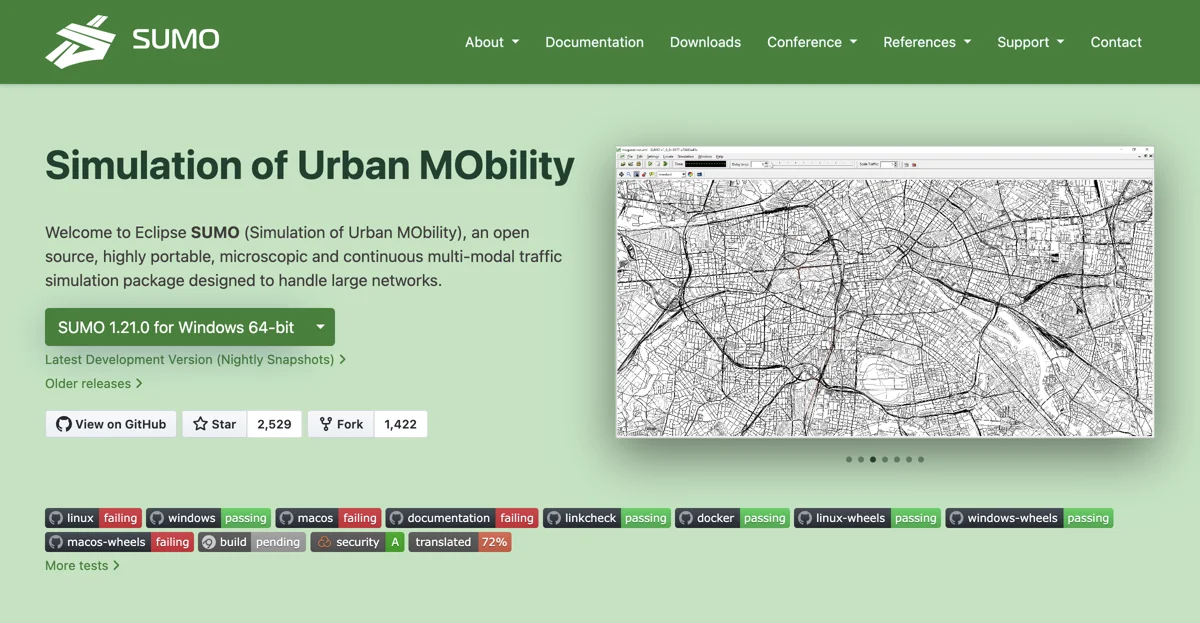Eclipse SUMO (Simulation of Urban MObility) is an open source, highly portable, microscopic, and continuous multi-modal traffic simulation package. It is designed to handle large networks and offers a wide range of features. SUMO allows for the modelling of intermodal traffic systems, including road vehicles, public transport, and pedestrians. It comes with a wealth of supporting tools for tasks such as route finding, visualization, network import, and emission calculation. Users can enhance SUMO with custom models and use various APIs to remotely control the simulation. The tool also enables the integration of automated vehicles and the implementation and evaluation of C2X communication technologies. It allows for the modelling of traffic management elements like video detectors and induction loops, as well as microscopic simulation of individual objects. SUMO supports the combination of different modes of transportation and provides online interaction to control the behavior of simulation objects. It offers features like modifying traffic light schedules, generating demand profiles, and boosting simulation performance. SUMO is portable and can be used on various platforms. Being open source, it can be used and modified according to users' needs. The SUMO User Conference, held annually in Berlin, is a significant event for the SUMO community. The future development of SUMO is shaped by the openMobility Interest Group at the Eclipse Foundation, with several partners from industry and academia collaborating towards a common mobility simulation platform.

Eclipse SUMO
Eclipse SUMO offers comprehensive traffic simulation with multiple features and portability.

Top Alternatives to Eclipse SUMO
AnyLogic
AnyLogic is an AI-powered simulation tool that offers diverse benefits
FlexSim
FlexSim is an AI-powered 3D simulation tool that aids in system improvement.
SpoofGPT
SpoofGPT is a unique AI tool that mimics generative AI interfaces, allowing users to craft custom responses for creative or humorous purposes.
Secret Desires
Secret Desires is an AI-powered simulation tool that creates immersive experiences, allowing users to customize and interact with virtual partners.
Showrunner
Showrunner is an AI-powered platform that enables users to create scenes, episodes, and entire TV shows using simulations.
AngryGF
AngryGF is an AI-powered simulator that helps users master comforting skills for stronger relationship bonds.
AGOGE.AI
AGOGE.AI is an AI-powered simulation tool that enhances communication skills through real-time, interactive dialogues.
FirePrep.chat
FirePrep.chat is an AI-powered training platform designed by firefighters to enhance first responders' skills and readiness through simulations and resources.
Project December
Project December is an AI-powered simulation tool that enables text-based conversations with anyone, including those who are no longer living.
Immersim AI
Immersim AI offers immersive role-play, storytelling, and podcast experiences in any world with any character.
CARLA Simulator
CARLA is an open-source simulator designed for autonomous driving research, offering a comprehensive suite of tools for development, training, and validation.
Hazy
Hazy is an AI-powered synthetic data platform that enables businesses to unlock faster, smarter, and more secure insights.
Retorio
Retorio is an AI coaching platform that offers scalable, impactful sales coaching for enterprises through customized AI simulations.
Tatship
Tatship is an AI-powered tattoo simulator that helps users visualize tattoos on their body before making a permanent decision.
Applied Intuition
Applied Intuition provides an AI-powered ADAS/AD toolchain, vehicle platform, and autonomy stack to accelerate vehicle software development.
trophi.ai
trophi.ai is an AI-powered coaching app that revolutionizes sim racing by providing real-time, personalized feedback to help drivers improve their performance.
UnravelX
UnravelX is an AI-powered simulation platform that enables rapid creation of 3D virtual worlds for immersive staff training.
Mursion
Mursion offers immersive learning simulations powered by human-driven AI to enhance workplace interpersonal skills.
NVIDIA Omniverse
NVIDIA Omniverse is a platform for developing OpenUSD applications for industrial digitalization and physical AI simulation.
NetLogo
NetLogo is a multi-agent programmable modeling environment used by students, teachers, and researchers worldwide.
Kaiden AI
Kaiden AI offers AI voice-enabled simulations for customized, feedback-rich training experiences.